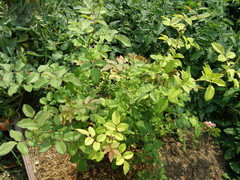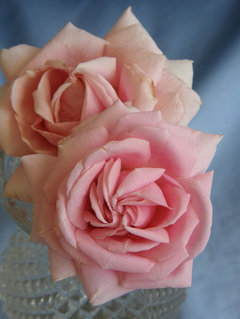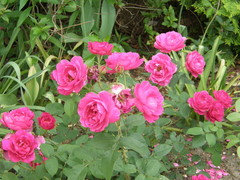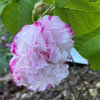How to have healthy soil & roses, organically?
Hello posters on the Organic Forum:
This is my first year of rose gardening and my roses are immature. I don't use chemical sprays, because I know it's healthier for all, but I don't really have a handle on what to do to prevent or correct problems. The internet is a great resource, but because I'm so new at this, sometimes the information goes over my head! So, here I am, hoping you can help clear some things up.
My Saint Patrick rosebush had two blooms that didn't open and someone on the rose forum suggested it might be caused by botrytis. But what do I do to prevent this? My other roses that are blooming are opening beautifully. I read about gypsum (Calcium sulfate) and sulfate of potash and wondered if this would help my soil and therefore the health of my roses. Also, can you tell me what calcium spray is and under what conditions it is used?
To give you a little more info, I live in zone 8b in southern California. According to the city water quality report, the ph of my water ranges from 7.08 to 8.10 with an average of 7.67. We have very hard water and our soil is on the slightly basic side. We are also in the worst drought in history and rely solely on our piped in water.
I have other questions, but I don't want to overdo it on my first post. Any advice on how to have healthy soil and roses would be appreciated. I'm a busy, working mom, but enjoy having a beautiful garden. Thank you in advance for your help.
Comments (21)
strawchicago z5
9 years agolast modified: 9 years agoHi Jasminerose: If you google "Calcium spray and botrytis" , you'll find the info. in the Rose forum where MichaelG talked about it. There's NO follow-up photos or documentation if that works.
You ask an excellent question, Jasmine. I always do my research thoroughly before I answer, even with my B.S. in Computer Science, and minor in chemistry. I also took microbiology, biochemistry & pre-med background.
There are many types of lime, see below link. The hydrated lime, or Calcium hydroxide in tap water is unstable and reactive. It makes the tap-water alkaline, plus binding with potassium, phosphorus & trace elements in soil. My roses don't bloom, plus pale, when given my tap water, pH above 8.
What causes balling? From what I researched, high nitrogen drives down BOTH potassium (to initiate blooming), and calcium (for bloom-formation). Thus equal or lesser amount of nitrogen to potassium is best for established roses. When I first got Liv Tyler rose, I gave it NPK 10-5-4, and the first bloom balled up. Same with Paul Neyron.
In both University of Kentucky and U. of Mass green house setting, the best ratio for best blooming and root-growth is 1 part nitrogen, 1/2 part phosphorus, 1 part potassium, 1/2 part calcium, and 1/4 part magnesium. Cow and horse manure also reflect that ratio. Hydroponics experiments also point to the same ratio for best root-growth.
When I gave Frederic Mistral rose too much potassium via sulfate of potash, many blooms balled up, became washed-out, plus browning of petals (botrytis) in our 2-weeks of rain. Only after I threw ground limestone (pH 9), that Frederic Mistral gave me perfect swirly petals, plus deeper pink. Ground limestone is different from hydrated lime, it's in a stable form that plants can use. Its pH is high, thus best with rain water (pH 5.6).
Here in Chicagoland, there's no-need for calcium spray, since my soil is dolomitic clay ... high in magnesium & barely adequate calcium due to calcium tied-up at my high pH of 7.7. There's no balling nor browning of petals for the 1st year with balanced horse manure, then the calcium got depleted, and that happened in the 3rd and 4th year.
Each spring I pruned huge amount of canes from our winter-kill down to the crown, thus there's a greater demand for calcium, potassium to regenerate those canes. Bacteria in the soil can fix nitrogen for plants, but calcium and potassium has to be supplied via fertilizer.
I posted pics. of roses with gypsum (calcium sulfate) in the planting hole: no balling whatsoever, nor browning (botrytis) of light-colored roses. Gypsum is twice the salt of limestone ... gypsum is acidic with 17% sulfur, best used to BREAK UP heavy & alkaline clay AT THE BOTTOM OF PLANTING HOLE. I already put gypsum ON TOP around roses, they broke out in rust, due to the sulfur in gypsum. Depends on the brand of gypsum, it ranges from neutral pH to acidic.
In our recent 2-weeks of rain, I tested ground limestone (pH 9) around roses: that stopped all the diseases, plus perfect firm petals that don't ball, don't brown, plus lasting longer in the vase. I don't recommend ground limestone on top, unless you get tons of rain at pH 5.6.
The heavier your clay is, the higher the pH. My soil is rock-hard heavy clay, and very sticky like mud, with high pH 7.7 ... 2 cups of gypsum in the planting hole supply calcium for a long-time. But if your soil is less alkaline, less sticky, and less heavy, 1 cup of gypsum in the planting hole is enough. It's caustic to earthworms, mix-in well then water immediately is best.
When I topped my roses with gypsum: BIG MISTAKE, I spent the entire day cleaning up the rust-disaster. Gypsum releases calcium immediately, which drives down potassium, necessary for disease-prevention. Gypsum has 17% sulfur, caustic to both earthworms and beneficial bacteria that suppress pathogenic fungi.
Lower the pH of soil-surface, and you'll get more fungal germination, be it rust, mildew, or black spots. I messed up my pots by topping them with pine-shavings (pH 4.5) .. they broke out in fungal diseases in our rainy weather.
The gritty texture-limestone I used is MORE ALKALINE than baking soda, thus prevent diseases, plus it's a slower release since it's gritty size, and only rain-water at pH 5.6 can break it down.
My local Menards sells powder-ground-limestone cheap, $4.49 for a 50 lbs. bag, that's more appropriate for acidic soil, since it's a finer powder, and raise the pH immediately. They also sell pelletized lime at $12 for 50 lbs. bag, it's a slower-release due to outer coating.
Thank you, Bonnie, for a great question that will help others. See the link below for types of calcium for best bloom formation. Less nitrogen is best for alkaline CA because bacteria in soil can fix nitrogen, plus nitrogen mobility is a 10, moves down easily. Compare that to potassium mobility of 3 (hardy move), and phosphorus mobility of 1 (stay put where applied). That's why SOLUBLE fertilizer works best in making roses bloom. Nitrogen is for growth & leaves only, versus potassium and phosphorus is for blooming.
Below picture is Francis Blaise rose, taken when I gave it too high nitrogen fertilizer, NPK 10-5-4, very pale due to high pH tap water 8, no blooms whatsoever. That was before I know about sulfate of potash and gypsum to lower water pH, and to induce blooming.
Here is a link that might be useful: Types of calcium for best bloom formation
This post was edited by Strawberryhill on Fri, Jul 4, 14 at 9:59
strawchicago z5
9 years agolast modified: 9 years agoPeople have the misconception that alkaline tap water has calcium. True, tap water has calcium, but it's in an UNSTABLE form, calcium hydroxide, that binds with potassium & phosphorus & trace elements in soil ... so roses don't bloom, or ball up.
What gypsum at 17% sulfur, and 22% calcium does is to lower the pH of tap water, so calcium will be released, along with potassium, phosphorus, and trace elements that were previously tied-up by the unstable calcium hydroxide in tap water.
When I tested 1 teaspoon of powder-gypsum (sold by Kelp4Less) with 1 gallon of water, I get immediate green-up of leaves, thanks to the 17% sulfur which also release potassium & phosphorus & trace-elements from tie-up in high pH. Salt index of gypsum is 8.1.
Sulfate of potash at 23% sulfur and 20% potassium act by LOWERING the pH with its 23% sulfur, plus releasing 20% potassium. More potassium & phosphorus are also released from the soil through balanced pH level. When I tested 1 teaspoon of sulfate of potash with 1 gallon of water, I get immediate green-up of leaves, plus explosion of buds. Salt index of sulfate of potash is 43, NPK 0-0-50.
Here in my Chicagoland, I use 1 teas of EACH per 2 gallons of water, due to my roses' died back to the crown this past winter. Also French roses and zillion-petals roses have a higher need for calcium. Plaster of Paris (drywall) gets the name due to the gypsum deposit in France.
I did that last year and got tons of blooms on Liv Tyler, a French rose, despite over 90 degrees temp, no rain, and with pH 8 hard-well water, see picture below, taken during our drought early August. Below link is sulfate of potash, sold for $8 a lb., free shipping from Kelp4Less. Since I have 50+ roses, I chose $12 for 5 lbs., also free shipping:
Here is a link that might be useful: Sulate of potash for $8 a lb., free shipping
This post was edited by Strawberryhill on Fri, Jul 4, 14 at 11:22
jim1961 / Central Pennsylvania / Zone 6
9 years agolast modified: 9 years agoIs the rose bush in question St. Patrick getting enough direct sun and water?
I think botrytis prevails in moist conditions...(High Humidity) You mentioned it has been dry... What was the weather like when the blooms on Saint Patrick did not open? Thanks
strawchicago z5
9 years agolast modified: 9 years agoHi Jim: That's a good point about Jasmine's dry condition in CA. When my Liv Tyler balled up, it was DRY and hot, and I gave it too much nitrogen fertilizer NPK 10-5-4. That Liv Tyler got tons of alkaline tap-water, but the bloom could not open.
Same thing happened with Paul Neyron: balled up during hot & dry weather, with tons of tap-water. Calcium-hydroxide in tap-water does that: it binds with potassium, phosphorus. And the calcium itself is NOT released either, due to high pH, thus the balling. Nitrogen is plenty in alkaline condition due to soil bacteria fixing nitrogen. If nitrogen fertilizer is also used, will result in poor blooming.
Below excerpt is from eHow on too much nitrogen: "Although a plant receiving a lot of nitrogen has a plethora of new, leafy foliage, there is often only foliage. It's difficult for fruit and flowers to grow when there is too much nitrogen in the soil. Fruit that does grow is distorted or doesn't ripen properly, while flower buds fall off or are disfigured if they do bloom."
Here is a link that might be useful: Effects of too much nitrogen
This post was edited by Strawberryhill on Sat, Jul 5, 14 at 7:52
jim1961 / Central Pennsylvania / Zone 6
9 years agolast modified: 9 years agoYou know with all the rain we get I've never had trouble with balling on any rose we had here...
So I really do not know much about balling or what all can cause it...So Strawbhill you say to much nitrogen and/or the tap water will cause it also...
One good thing is Jasmine is only having trouble with one rose bush...
Jasminerose, California, USDA 9b/Sunset 18
Original Author9 years agolast modified: 9 years agoThank you, Strawberryhill and Jim. Happy 4th of July.
According to our weather report, the humidity was 53% today, but it hasn’t rained in a long time. As I remember, it sprinkled twice last winter for about six minutes.
My Saint Patrick rose is in its first year. I wonder if I need to cut back on the attention I’m giving it. Perhaps I’m giving it too much water or high nitrogen fertilizer. Perhaps it’s not getting enough sun. It’s confusing, because my other roses seem to like how I’m treating them. But I’m learning that all roses are not the same. Some grow like weeds :) Hopefully Saint Patrick will grow out of this issue. I certainly like this rose in my friend’s garden.
I’ve had two casualties in my garden so far, Blue for You and Glowing Amber. Both were fried by our southern California heat. I learned quickly that 6 hours of sun doesn’t mean full southern California sun. Saint Patrick is listed as heat tolerant, though, it needs a sunnier location.
Strawberryhill, I appreciate the link to Kelp4less. It looks like a good site. Your Liv Tyler rosebush is beautiful.
strawchicago z5
9 years agolast modified: 9 years agoHi Jasminerose: You are right about roses are different from each other. I checked on St. Patrick in HMF. The comments confirm that it needs more calcium and potassium ... easily done by watering with 1 teas. gypsum and 1 teas. sulfate of potash per 2-gallons bucket of water.
Kelp4Less sells POWDER gypsum (calcium sulfate) that dissolve easily in my pH 8 tap water, 5 lbs. for $10. Only give to rose what it uses, excess will cause diseases. Excessive sulfur will induce diseases (rust, BS, mildew) ...
Long-term solution is to dig that up, and put GRANULAR gypsum in the planting hole for slow-release, which I did yesterday to Le Rire Niais. I also mixed in red-lava-rocks (high potassium & high iron & trace elements) in twice the amount of granular gypsum. Le Rire Niais is so hopeless, it doesn't bloom whatsoever since last July when I got it 1/2 price from Roses Unlimited.
Roses with thick petals that last 1 week in the vase like St. Patrick can withstand heat, but they demand more calcium than average. Take Romantica Frederic Mistral, a French rose known for heat-tolerant and long-vase life. It's stingy in blooms for 2 years, until this 3rd year I gave it sulfate of potash. BOOM ! 70+ buds for spring flush. I was elated, but the blooms balled, bleached out to white, and petals became brown (botrytis) in rain.
I spread ground limestone (pH 9) on top, to counter-act our 2-weeks of rain (pH of rain is 5.6). I meant to prevent black spots ... to my surprise, the blooms stopped balling, open nicely with firm & pretty swirls, plus a deeper-pink from the red-lava rocks I put on top. Red lava rock is high in iron & trace elements to deepen blooms' color.
Below is Frederic Mistral blooms, with limestone (high calcium) and red-lava rocks (high potassium, iron, and trace elements). Picture taken in our recent 2-weeks of constant rain ... the blooms also last longer in the vase.
Here is a link that might be useful: Kelp4less 5 lbs. of gypsum for $10
This post was edited by Strawberryhill on Sat, Jul 5, 14 at 8:39
Jasminerose, California, USDA 9b/Sunset 18
Original Author9 years agolast modified: 9 years agoStrawberryhill:
That was very nice of you to research the needs of my Saint Patrick rose. Thank you :) I knew it was a rose with thick petals, but I didn't know that type requires more calcium. I will purchase the gypsum and sulfate of potash.I did a Google search on Lava rocks for roses. They are not recommended in my area, because the high heat turns the rock into barbeque stones that will burn the roots. However, chelated iron is recommended, so I will look into that.
Hope you enjoy the weekend. BTW, I’m still in the disbudding stage with Annie Laurie McDowell, so she will climb. I don’t mind so much, because she has beautiful leaves, but I always enjoy your photographs of this rose.
strawchicago z5
9 years agolast modified: 9 years agoHi Jasmine:
I find that red-lava-rocks IN THE PLANTING HOLE works better than as mulch. Years ago I buried a trench of red-lava-rocks .... I meant to stop pink yarrow from invading, but it backfired, and the perennials went beserk with blooms. Both of my neighbors complimented on my garden that year. Red-lava rocks IN THE PLANTING HOLE supply slow-released potassium & iron, and trace-elements.
There's a thread on molasses in this forum, which I listed no-salt, "Wholesome Organic Molasses" at $6 per bottle, with its high potassium & calcium, and IRON & trace elements, plus its NPK. I have a bottle of molasses mixed with water & sulfate of potash & gypsum which I use 1 teaspoon per 2-gallon of my tap-water. Excellenz von Schubert rose likes it acidic, and does well with that approach.
Citric acid is sold at Health Food store for sprouting, low pH at 4, and dissolve instantly in water. I spent $20 on citric acid for 2 years, before I know about sulfate of potash & gypsum & molasses (for iron). I was NOT impressed with the root-growth in citric acid, did not green up either.
Sulfate of potash & gypsum & molasses produce better root-growth, deeper colors, plus more flowering. Citric acid has no salt, so it's still useful to use in between fertilizations. Soluble fertilizer is recommended at diluted dose twice a week, and NOT with every watering.
Found info. that Vitamin C (ascorbic acid) is even better than citric acid ... that will lower tap-water pH, plus helps plants to grow. See info. from Yahoo! on the acidity of vitamin C, or Ascorbic acid
pH : 3 (5% sol.)
http://chemicalland21.com/lifescience/fo...
5% solution in water has a pH of 2.2 - 2.5.Also info. from below link on Vitamin C:
"Plants must have vitamin C in order to grow, according to Professor Nicholas Smirnoff of the University of Exeter, England. Partnering with researchers from the University of Shimane, Japan, his research team genetically-engineered plants lacking vitamin C, which did not grow. Previously, vitamin C was considered merely an antioxidant that helped protect plants against the effects of the sun, such as drought and UV radiation, to successfully complete photosynthesis."
Here is a link that might be useful: The effects of vitamins on plants' growth
strawchicago z5
9 years agolast modified: 9 years agoI'm sorting out my memories of the many pots I grew for the past 3 years ... too many experiments to keep track. Yes, I had better luck with used lemons (with vitamin C) than citric acid. I used citric acid initially, but switched to used lemons (cheaper & more effective with vitamin C).
Below link is a slide-show by eHow that lists what vitamins are beneficial to plants. Initially B1, or thiamine, was thought to help root-growth but many studies found that it's useless, but still good to prevent diseases. Corn is high in thiamine & phosphorus plus anti-fungal agents of zinc and copper. I put tons of cracked corn in the planting hole of Golden Celebration, it gives me twice more blooms, plus 100% healthy. It was worth it to dig that up last fall.
Used lemons is high in vitamin C, plus 1/2 used lemons can make 5 gallons of water slightly acidic. VERY POTENT, but in diluted form helps plants. I almost killed Wise Portia rose in the winter by giving it 1 gallon water, dunked with 1 used grapefruit. But for the next 2 years, that was MY BEST AUTIN in growth !!! It must be the vitamin C. See Wise Portia rose below, bloomed way-more after that "failed" grapefruit experiment.
Here is a link that might be useful: eHow on vitamins for plants
This post was edited by Strawberryhill on Sat, Jul 5, 14 at 13:49
Jasminerose, California, USDA 9b/Sunset 18
Original Author9 years agolast modified: 9 years agoStrawberrhill:
I saw an old post of yours that said you used citric acid with Vitamin C to help dissolve the gypsum. Is that still your practice?Wholesome Organic Molasses looks like a good source for blackstrap molasses. I saw this recipe on the soil guy website. He recommends aeration for beneficial microbes.
Molasses and Alfalfa Tea Mixture:
4 gallons (15.2 liter) of water 1 cup (225 ml) of fine ground alfalfa meal 1 tablespoon (15 ml) blackstrap or sugar beet molasses
Allow this to sit for 24 hours, and then it is ready for application as a soil drench. As a foliar feed, recommend straining the mixture so there is nothing to clog the spray head.Here is a link that might be useful: The soil guy on molasses
strawchicago z5
9 years agolast modified: 9 years agoThat was with Menards' $6 per tiny bag of gypsum that gunked up like plaster. The Kelp4Less gypsum-powder dissolved easily in my pH 8 tap water, so I stopped using used lemons and citric acid.
It's good to use citric acid, or better yet, used lemons to lower tap water pH for in-between the once-every-2-weeks fertilization of gypsum & sulfate of potash.
All the scraps & used fruits with vitamin C: strawberries, oranges, kiwi, grapefruit are great to lower the pH of alkaline tap water. I put those in my compost & good for the soil.
This post was edited by Strawberryhill on Sat, Jul 5, 14 at 17:10
Jasminerose, California, USDA 9b/Sunset 18
Original Author9 years agolast modified: 9 years agoGood to know. I have a lime tree so that should be no problem.
Thank you.
strawchicago z5
9 years agolast modified: 9 years agoHi Jasmine: That fertilizer recipe of 4 gallons water & 1 cup alfalfa meal & 1 T. molasses sound great !! Thank you.
Few mistakes that I did which I hope others won't repeat:
1) Last year: The deer ate Sweet Promise and Firefighter hybrid. They were so bare without leaves, so I gave them high nitrogen fertilizer NPK 10-5-4. That burnt both in high heat, plus drove down potassium & calcium. Both had lousy blooms, plus cane-borers invaded Firefigher's weak stems.
2) Chicken manure is best only twice a year due to its salt. GERDA in HMF, zone 6b, has the best garden, and she uses chicken manure twice a year, after 1/2 bucket of cow manure in spring . Jeanie in PNW informed that the rose park fertilized with animal dung in the spring, and nothing afterwards. Cantigny Rose park here did that a decade ago, and it was their most healthy year.
3) My most healthy rose, and best blooms to leaves ratio is Arthur Bell. I did nothing, except chicken manure before the ground freezes, and the second time early spring. 100 % healthy with glossy foliage.
4) My worst rose, full of black spots, is Yves Seedling #2. It went from 100% healthy early spring (winterized with manure & cracked corn), to disease-fest. That rose has the most salt-damage: 2 applications of chicken-manure, plus sulfate of potash to produce more blooms, then ground limestone & red lava rock, then 2 soluble MiracleGro. I tested to see if chemical fertilizer induce black spots, and it sure did.
5) The stingy roses like Frederic Mistral, Jude the Obscure and Eglantyne BENEFITED from once a month of sulfate of potash & gypsum .. more blooms. Frederic is still clean with ground-limestone & red lava topping. Jude and Eglantyne broke out in B.S. with MiracleGro soluble. Salt in chemical fertilizer drives down potassium, necessary for disease-prevention.
6) Comte de Chambord in the ground is still clean with one application of sulfate of potash & ground limestone & red lava rock. Old Port next to it gets 2 applications of MiracleGro, and broke out in black spots.
For pots: Duchess de Rohan and Rose du Roi gets sulfate of potash & gypsum ... both are still clean. Wimpy Duchess de Rohan also gets blood meal and some chicken-manure, still 100% healthy. Chicken manure is high in boron, zinc, and copper. Both zinc and copper are anti-fungal agents.
La Reine and 2nd Comte de Chambord in pots: Both broke out in horrible black spots after 2 MiracleGro applications this month. I use less than half the amount recommended.
7) Same report with roses in front: none of these had brewer's yeast nor rice bran. The ones that got chicken manure only are 100%, the ones that got MiracleGro broke out in black spots immediately. I can't wait until more rain to de-salt the damage of chemical fertilizers. Less is best, and slow-released like manure is best.
8) Few years ago I used Lilly Miller acid fertilizer NPK 10-5-4 with chicken manure, plus chemicals. Great spring flush, I get impatient, and give it the SECOND time early June. It got hot & dry, and Mary Magdalene broke out in mildew, DID NOT improve no matter how much tap-water I gave. So this year I learn my lesson: nothing on Mary, except spring application of chicken manure. She's 100% clean, tons of buds. Below is Mary Magdalene's 2nd flush, taken today July 5.
Jasminerose, California, USDA 9b/Sunset 18
Original Author9 years agolast modified: 9 years agoStrawberryhill: Have you seen any difference with the roses that got the brewer's yeast?
strawchicago z5
9 years agolast modified: 9 years agoHi Jasminerose: Thank you for asking the most well-thought and intelligent questions. I gave a few wimpy roses two applications of brewer's yeast (BY), but I took brewer's yeast for 7 days. I notice a tremendous energy surge (like caffeine), improved mood, and stable-blood-sugar (from chromium in BY)... I couldn't care less about eating, no hunger pangs, no cravings.
I like it so much that I kept on taking for 7 days straight ... until Friday, which I took brewer's yeast along with green tea (high in caffeine). I was so hyper that I could not sleep until 1 am, then woke up really early this morning. Brewer's yeast definitely stimulates and energizes the body, NOT best with caffeine.
Brewer's yeast effect on wimpy roses that nearly died in our worst zone 5a winter? I tested it on roses that are still less than 6 inch: Summer Samba and Eglantyne, plus band-size roses in pots. Due to the heavy rain, only the ones in the ground benefited from Brewer's yeast. My clay retains nutrients well, versus leaching in pots.
I did not give King Arthur any, it hasn't bloomed yet. Summer Samba opened its bright orange petals. Eglantyne went from sick-looking, to new leaves and fat buds. Jude the Obscure survived winter better than Eglantyne, DID NOT get Brewer's Yeast, and DID NOT sprout any leaves nor buds.
I see a speed-up in bud-progression with Brewer's yeast. The growth rate of new leaves CANNOT match that of alfalfa-tea. I tested alfalfa-tea before, with at least 4 inches of new growth.
Conclusion: Making blooms require a lot of energy, if I want blooms sooner, I would definitely apply brewer's yeast. B-vitamins maintain health in humans and plants.
Austin rose Eglantyne is blackspot-prone. This month I tested these on Eglantyne: sulfate of potash, ground limestone (it turned pale), red lava rock, plus 2 applications of MiracleGro. It's surprisingly healthy, considering that its neighbor Jude the Obscure broke out in B.S. with MiracleGro.
Below picture of own-root Eglantyne was taken 2 days ago, now the 4 buds are much bigger. Eglantyne is the most stingy Austin rose on own-root. Picture is the start of 2nd flush.
This post was edited by Strawberryhill on Sat, Jul 5, 14 at 22:49
Jasminerose, California, USDA 9b/Sunset 18
Original Author9 years agolast modified: 9 years agoI have problems with high blood sugar, so I'll check out the Brewer's yeast for myself as well as the garden. I'll take it in the morning, so I won't have trouble sleeping. Thanks and hope you sleep well, Stawberryhill.
jim1961 / Central Pennsylvania / Zone 6
9 years agolast modified: 9 years agoI'm seeing what appears to be a speed up in bud progression also with the application of Brewers Yeast to one of our roses...
Hope you sleep better Strawbhill and please check your HMF messages... Thanks
strawchicago z5
8 years agoUPDATE: Encap-dry-compost experiment was a disaster. I was NOT impressed when I topped pots with that stuff last summer. I put a bunch of Encap-dry-compost (made of cow-manure and leaves) into the hole of La Rein: 10 blooms for a tiny plant, but it broke out in leaf-burn and black-spots after blooming. I suspect the salt in the Encap-dry-compost and the high phosphorus in manure. Will post pic. later of that failed experiment.
msdorkgirl
8 years agoI get so easily distracted with information but it is good info. Thank you for bringing this thread up Straw. I am very interested in knowing what your current regimen is for feeding your roses (what you do weekly, once a month, etc).
I have a couple of stores to purchase the red lava rock with the smallest textures that I plan to layer in as well as mix in my potting medium. If I end up potting all 4 Austins I will need two more bags of potting mix and the roots are a lot bigger than I expected (grafted on Huey I think).



























strawchicago z5